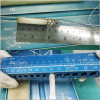Short graft, short tunnel ACL reconstruction with single hamstring and internal brace leads to comparable outcomes to conventional double hamstring technique: A retrospective study
- PMID: 40655259
- PMCID: PMC12255932
- DOI: 10.1002/jeo2.70338
Short graft, short tunnel ACL reconstruction with single hamstring and internal brace leads to comparable outcomes to conventional double hamstring technique: A retrospective study
Abstract
Purpose: The purpose of our study was to compare (1) ACL graft healing, (2) patient-reported outcome, and (3) complications after short graft (length < 65 mm), short tunnel (femoral tunnel < 20 mm) single hamstring ACL reconstruction with an internal brace (SGST-ACLR) technique and double hamstring autograft conventional ACL reconstruction (CON-ACLR) technique at minimum 2-year follow-up.
Methods: A retrospective cohort of patients underwent arthroscopic ACL reconstruction using a hamstring graft, with a minimum 2-year follow-up. Graft healing was evaluated at 1 year using a magnetic resonance imaging scan, with the mean signal-to-noise quotient ratio (SNQ) measured from three areas: proximal, middle, and distal to the ACL graft. Patients' demographics data, meniscal lesion, chondral lesion, time to operation, time to evaluation, PROMs (International Knee Documentation Committee [IKDC] scores, Tegner activity scale, and Lysholm score), and complications were evaluated. ACL laxity was measured using a side-to-side difference (SSD) by a lachmeter.
Results: A total of 51 patients, comprising 25 in the SGST-ACLR group and 26 in the CONV-ACLR group, were analysed. The ACL graft diameter was comparable between the two groups (p = 0.32). The mean SNQ at 1-year postoperative MRI showed no significant difference (p = 0.21). Furthermore, no statistically significant differences were observed in the postoperative IKDC scores (p = 0.36), Lysholm scores (p = 0.22), Tegner activity scores (p = 0.30), or side-to-side differences (p = 0.38) at the final follow-up.
Conclusion: At two years postoperatively, this study demonstrates that SGST-ACLR with an internal brace provides comparable outcomes in all parameters to CONV-ACLR. Thus, SGST-ACLR offers a viable alternative technique for ACL reconstruction, with the added advantage of minimising graft usage.
Level of evidence: Level IV, retrospective cohort study.
Keywords: all‐inside technique; anterior cruciate ligament reconstruction; short graft short tunnel ACLR.
© 2025 The Author(s). Journal of Experimental Orthopaedics published by John Wiley & Sons Ltd on behalf of European Society of Sports Traumatology, Knee Surgery and Arthroscopy.
Conflict of interest statement
The authors declare no conflicts of interest.
Figures




Similar articles
-
Partial Transphyseal All-Inside Anterior Cruciate Ligament Reconstruction in Skeletally Immature Adolescent Patients: Two-Year Minimum Follow-up Clinical and Radiologic Results.Orthop J Sports Med. 2025 Jun 26;13(6):23259671251350298. doi: 10.1177/23259671251350298. eCollection 2025 Jun. Orthop J Sports Med. 2025. PMID: 40584089 Free PMC article.
-
All-inside ACL Reconstruction Offers No Advantage in Clinical Outcomes, Graft Healing, or Tunnel Widening Compared With the Complete Tibial Tunnel Technique: A Prospective Randomized Trial.Clin Orthop Relat Res. 2025 Jul 29. doi: 10.1097/CORR.0000000000003638. Online ahead of print. Clin Orthop Relat Res. 2025. PMID: 40762570
-
Anterior Cruciate Ligament Reconstruction With Unilateral 8-Strand Hamstring Tendon Autograft Demonstrated Promising Clinical, Radiological, and Second-Look Arthroscopic Outcomes at 2-Year Minimum Follow-up.Orthop J Sports Med. 2025 Aug 8;13(8):23259671251358404. doi: 10.1177/23259671251358404. eCollection 2025 Aug. Orthop J Sports Med. 2025. PMID: 40786917 Free PMC article.
-
Anterior Cruciate Ligament Repair Augmented With Dynamic Intraligamentary Stabilization Is Equivalent to Hamstring Autograft Reconstruction at Short- and Mid-Term Follow-Up: A Systematic Review.Arthroscopy. 2024 Jul;40(7):2121-2131.e1. doi: 10.1016/j.arthro.2023.12.011. Epub 2024 Feb 27. Arthroscopy. 2024. PMID: 38417640
-
Hamstring autograft, bone-patellar-tendon-bone autograft and synthetic graft in primary anterior cruciate ligament reconstruction: A meta-analysis of comparative studies.J Exp Orthop. 2025 Jul 18;12(3):e70326. doi: 10.1002/jeo2.70326. eCollection 2025 Jul. J Exp Orthop. 2025. PMID: 40689103 Free PMC article. Review.
References
-
- Balendra G, Willinger L, Pai V, Mitchell A, Lee J, Jones M, et al. Anterolateral complex injuries occur in the majority of ‘isolated’ anterior cruciate ligament ruptures. Knee Surg Sports Traumatol Arthrosc. 2022;30(1):176–183. - PubMed
-
- Cavaignac E, Marot V, Faruch M, Reina N, Murgier J, Accadbled F, et al. Hamstring graft incorporation according to the length of the graft inside tunnels. Am J Sports Med. 2018;46(2):348–356. - PubMed
-
- Chiang ER, Ma HL, Wang ST, Hung SC, Liu CL, Chen TH. Hamstring graft sizes differ between Chinese and Caucasians. Knee Surg Sports Traumatol Arthrosc. 2012;20(5):916–921. - PubMed
-
- Colombet P, Graveleau N, Jambou S. Incorporation of hamstring grafts within the tibial tunnel after anterior cruciate ligament reconstruction: magnetic resonance imaging of suspensory fixation versus interference screws. Am J Sports Med. 2016;44(11):2838–2845. - PubMed
LinkOut - more resources
Full Text Sources
Research Materials

